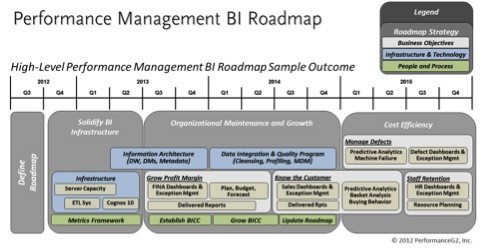Anyone can build a roadmap. It’s simple, right? Just outline the organizational business objectives and enhance the existing BI environment to deliver content aligned with business objectives. While creating a roadmap seems this simple, it is not. An effective organizationally aligned roadmap will not only study the business objectives but, assess the technologies, people and processes necessary to support the development and delivery of the BI solutions. Without addressing these infrastructure elements, a roadmap is nothing more than words on paper. Even with an infrastructure assessment, the defined solutions are not feasible for execution without the organization wide vision and executive support.
How can an organization ensure a proper and realistic roadmap is developed? There are a number of different types of roadmap approaches and an organization needs to select the best approach for their organizational maturity and BI evolutionary state. For instance, there are BI Roadmaps with a focus on BI departmental strategy, which presents the strategies, intentions, and initiatives for the organization. These roadmaps help to birth and organize a BI department and identify initial strategy, but this approach is not applicable for the alignment of business objectives to BI solutions. To create an effective BI solution focused roadmap, an organization should follow a business intelligence related theory, like performance management. Applying performance management theory will ensure each tactical project is delivered to meet user requirements while aligning with business objectives.
According to Gartner, two elements become crucial in supporting a broader approach to performance management: the metrics framework that links performance measures across the enterprise and the information architecture required to provide a consistent data environment for these diverse applications and processes. This is why BI and performance management must be considered in harmony as part of a broader roadmap initiative. If the performance management objectives are missing, an organization will struggle to leverage information as an asset. The Performance Management BI Roadmap provides the directions for transporting the organization from the current state to the desired state.
The comprehensive Performance Management BI Roadmap assesses multiple contributing factors of BI from both the technical and business perspectives. The roadmap will ensure an organization delivers targeted actionable information to support business objective supported decision-making in a variety of user convenient mediums. Additionally, the roadmap will evaluate if the organization supporting BI is technically skilled in the right areas and able to efficiently and effectively identify, classify, organize and deliver BI solutions. In order to ensure users obtain appropriate service levels the BI supporting technical infrastructure should be appraised. Focusing on these factors will allow an organization to move from report management to decision support.
The Performance Management BI Roadmap guides the foundation for a 21st century performance management system focused on delivering actionable business objective supported information throughout a functional area or even the entire organization. It includes recommendations providing quick wins for the business, as well as a strategy for consistent and productive organization-wide performance management now and well into the future. It will provide solution and technology architectures for the tools and solutions, ensuring user will have appropriate service levels. Each of these elements are brought together to deliver a quarterly view of prioritized tactical projects for the short, medium, and long-term time horizons.

For more information on how your organization can get started building a successful Performance Management BI Roadmap, connect with us at info@performanceg2.com or call 877.742.4276.

